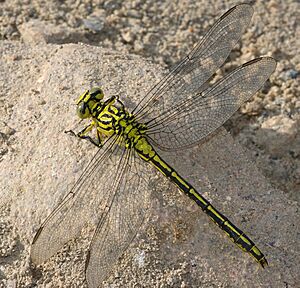River clubtail facts for kids
Quick facts for kids River clubtail |
|
|---|---|
 |
|
| Scientific classification | |
| Genus: |
Gomphus (dragonfly)
|
| Species: |
flavipes
|
| Synonyms | |
|
Stylurus flavipes |
|
The Gomphus flavipes, also known as the river clubtail or yellow-legged dragonfly, is a type of dragonfly. It belongs to the Gomphidae family. You can find these dragonflies in Europe. They love living near rivers and large streams. These dragonflies usually fly from June to September, depending on where they are.
Contents
Where They Live
The Gomphus flavipes is a European dragonfly. It has the largest range among similar European species. You can find it from France all the way to eastern Siberia. However, it's not found everywhere in Central Europe. It has become quite rare in Western Europe. The furthest south it has been seen is in Greece. In Southern Europe, other types of Gomphid dragonflies live instead. Scientists are still working to map out its exact living areas.
Their Home
Gomphus flavipes dragonflies live along the middle and lower parts of rivers. They like rivers that flow slowly and are medium to large in size. These dragonflies prefer riverbeds with soft soil like mud, clay, or fine sand. This is because their young, called larvae, bury themselves in the soil. They avoid areas with lots of rotting plants or water that doesn't have much oxygen. They also stay away from fast-flowing parts of rivers with rough rocks. Sometimes, you might even find them in bigger lakes that have plenty of oxygen.
What They Look Like
The Gomphus flavipes is a medium-sized dragonfly. It is about 50–55 mm long. Its wings can spread about 70–80 mm wide. A special feature of this type of dragonfly is that its eyes are far apart. Male dragonflies have blue eyes, while females have green eyes. Both male and female Gomphus flavipes have mostly yellow legs. The males also have thin, angled parts at their tail end. The top of their 10th body segment is completely black.
Behavior and Life Cycle
Like all dragonflies, Gomphus flavipes are predators. This means they hunt and eat other smaller insects while flying. Adult dragonflies are not often seen. The best times to spot them are when they are mating or when young adults first appear. Mating usually happens in June or July. During the day, male dragonflies look for females. They fly low over the water, away from the riverbank. After mating, female dragonflies fly about 20–30 cm above the water. They lay their eggs one at a time or in small groups into the water.
Larval Development
The larvae of the Gomphus flavipes live for three years. They stay buried in the fine soil at the bottom of the river. Just like the adults, the larvae are also predators. They eat small invertebrates, which are tiny creatures without backbones. They catch their food using a special mouthpart called a mask. This part can shoot out to grab prey.
The young dragonflies usually start to emerge from the water in late May or June. However, this can change depending on the location and weather. For example, a lot of rain might delay their emergence. Many Gomphus flavipes larvae emerge at the same time. This is why they are called a 'summer species'. Unlike other dragonfly larvae, Gomphus flavipes larvae often choose the riverbank soil to emerge from. The type of soil they choose can depend on the riverbank's features.
What Harms Them
The Gomphus flavipes has become an endangered species in many Western European countries. This is mainly because of water pollution and changes made to rivers. The species is listed in Annex IV of the Habitats Directive. This means it is a protected species.

